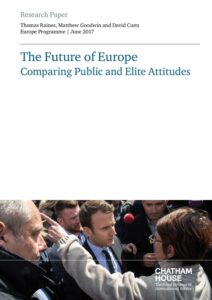The paper begins by examining the political trends that are shaping politics across Europe. It then outlines how the data demonstrate a continent that is split along three fronts. First, there is a divide between elites and the public. Although there is some alignment in their respective attitudes to solidarity, democracy and the EU’s achievements, there are also pronounced differences in terms of broader political values, feelings towards the EU, and attitudes to diversity and immigration. Second, there is a societal divide among members of the public whose diverging values are pulling Europe in two different directions. Third, there is a lack of consensus among the elite on important questions about the EU’s direction. The final chapter considers the implications of these results for the future of the EU. It argues that divides within the public are as significant as divides between states, and that addressing them will require different strategies. To better reflect the diversity of public and elite perspectives, the EU needs to move beyond a binary debate of its future. And given the lack of a consensus, and the relative political stability that should follow this year’s elections, there is the space for new ideas and vision to germinate.


